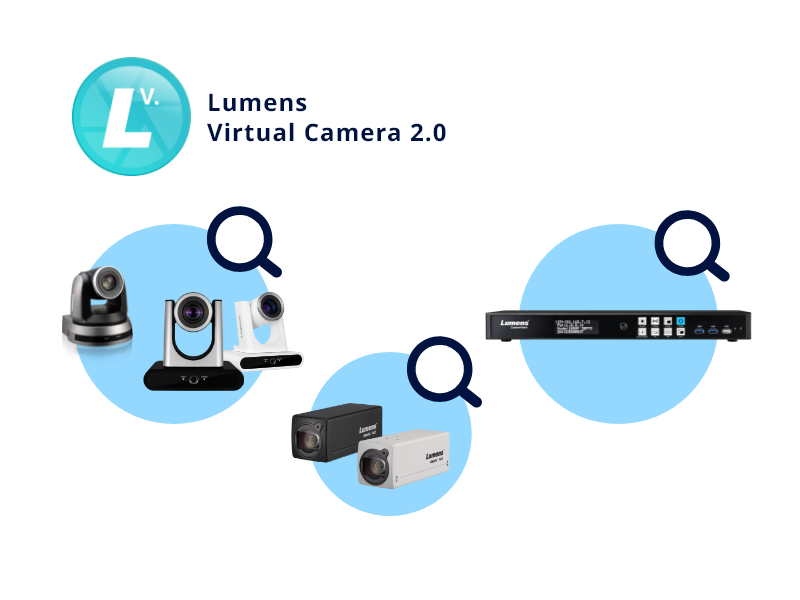Virtual Camera 2.0

Bringing a new level of quality, flexibility, and control to your video conferencing
Webcams are usually connected by a USB cable to a computer. This is simple, quick and reliable, and is the standard for video conferencing set ups around the world. With Lumens' Virtual Camera software there is now another option. The software allows users to connect a Lumens professional IP camera to the host computer using Ethernet. Just attach the Lumens IP camera or Lumens Media Processor to the LAN using a standard network cable and it's now ready for use.
Why use Lumens Virtual Camera 2.0?

1. Fast Installation and easy management
Increasingly, AV infrastructures operate on Ethernet networks. With Virtual Camera software, a Lumens camera can be attached anywhere on the Ethernet network and immediately used as a video conference source. There is no need for long USB cables directly attached to a PC or for IT to manage the settings. With Lumens, the camera can be managed, controlled, and routed remotely over the network, saving the AV and IT teams both time and money.

2. Flexibility
Most webcams are limited to a single role as a video conferencing camera. By installing an IP camera onto an Ethernet network, AV teams also have a high-quality capture device for video conferencing, live streaming, multi-camera event production, or lecture recording.

3. Support Lumens Pro AV Camera and Media Processor
With Virtual Camera 2.0 software, AV technicians can use a professional Lumens HD or 4K which produces outstanding picture quality. It also has the optical zoom capability to capture a single presenter or an entire panel without pixelating the picture. Virtual Camera 2.0 software also supports the Lumens Media Processor which is a multi-channel switcher, recorder and encoder. The Lumens Media Processor can output directly to video conferencing software, to deliver a collaborative meeting that is far more engaging for remote participants.

4. Support virtual Video/Audio driver and Audio Delay function for synchronization
In video conferencing, audio and video synchronization is a core requirement. In addition to supporting video, Virtual Camera 2.0 also supports audio and provides the function of setting audio delay to achieve perfect audio and video synchronization.

5. Fully support standard UVC control
Lumens Virtual Camera Software supports all major video conferencing software and unified communication platforms, including Teams, Skype, WebEx and Zoom. It is also compliant with live production systems such as vMix, OBS and Livestream. Lumens Virtual Camera 2.0 supports a standard control interface, which allows most software to control the camera easily and quickly.
Comparison Virtual Camera 2.0 and 1.0
| SOFTWARE FUNCTION | 2.0 | 1.0 |
| Supports Lumens Pro AV Cameras | Yes | Yes |
| Support Lumens Media Processors | Yes | No |
| Virtual Video driver | Yes | Yes |
| Virtual Audio driver | Yes | No |
| Support Audio Delay | Yes | No |
| Fully support standard UVC control | Yes | No |
| Microsoft WHQL Certification | Yes | No |
| Source can be switched dynamically | Yes | No |
| Software Password Management | Low Latency (20% reduction) |
Normal |
Minimum System Requirements
| CPU | Intel Core i3 gen 8 above or AMD Ryzen 3 2200 series above |
| RAM | 8 GB |
| GPU | Integrated Graphics Card |
| OS | Windows 10 (64 bit) / Windows 11 (64 bit) |
| Storage | 10 GB available space |
| Display Resolution | 1920 x 1080, 50/60 fps |
| Network | 10 / 100 / 1000 Base-T |
Recommended System Requirements
| CPU | Intel Core i7 gen 10 above |
| RAM | 8 GB |
| GPU | NIVIDA GTX 1060 above |
| OS | Windows 10 (64 bit) / Windows 11 (64 bit) |
| Storage | 10 GB available space |
| Display Resolution | 1920 x 1080, 50/60 fps |
| Network | 10 / 100 / 1000 Base-T |



